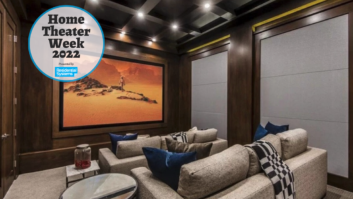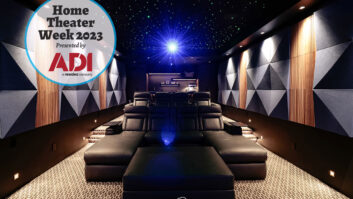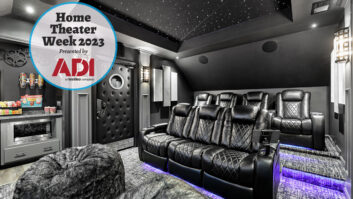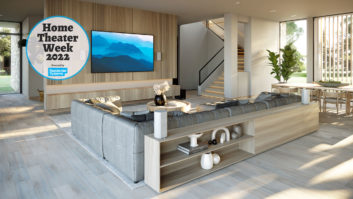When it comes to home theater systems, more is usually better in the eyes and ears of the client. For evidence we need only look at what has happened on the video side, as pixel counts look to surpass the barely established 4K on its road to staggering 8K. But at least you don’t have to find new places to put those pixels in a room — a luxury not afforded on the sound side when moving beyond 5.1 to, for example, a full Dolby Atmos system, which can go as high as 24.1.10 channels.
So how have home theater speaker manufacturers worked to accommodate the new wave in home theater sound? We checked in with leaders from Theory Audio Design, Origin Acoustics, and Klipsch to find out.
Paul Hales, president of Pro Audio Technology and Theory Audio Design, identifies one of the key issues affecting home theater designers today — and one of the solutions: “To fully reproduce Dolby Atmos, more loudspeakers and subwoofers are required than traditional 5.1 systems, and while budgets have expanded to accommodate higher-channel count systems, they haven’t expanded linearly with the number of loudspeakers needed. This shift has caused speaker manufacturers to create smaller surround speakers in order to offer lower priced solutions.”

Theory’s approach is to provide listeners with small components that can be integrated into a home theater or mixed-use room, including a range of high-output soundbars, in-wall and on-wall speakers, and subwoofers. “Historically, soundbars and small on-wall type loudspeakers have lacked the acoustic power to convincingly re-create a motion picture soundtrack anywhere near reference level,” says Hales. “Theory was created to address this deficiency directly, head-on, and with the focus of an entire business behind the concept.”
For Origin Acoustics, “thin is in” as a way of fitting in additional speakers. Its new Marquee Collection is a hybrid between architectural and cabinet speakers. “Utilizing extruded aluminum enclosures, we are able to create incredibly thin cabinets that can hang on the wall or be installed flush in the wall,” says Nick Berry, CEO of Origin Acoustics. “Because of aluminum’s strength, the walls of the enclosures are remarkably thin, allowing for maximum area volume within. This results in more bass and a smoother transition to the subwoofer channels.”
Michael Buratto, product manager for Klipsch, mentions the customer’s desire for more performance from a smaller footprint. “You’ll always get better performance out of more airspace,” he says, “which typically means a floorstanding or box speaker, but these aren’t for everyone. We put a lot of development into matching the voicing of the new Klipsch Pro Series Reference and Reference Premiere architectural lines with the box speaker sister lines. And for the first time, we’ve achieved Reference and Reference Premiere performance in architectural speakers.”

Indeed, Klipsch has aggressively added to its CI offerings. “Over the past 18 months, we’ve introduced over 75 new architectural speaker models that are dedicated to the custom installation space — and are not available in mass or online retail,” says Buratto. “In developing these lines, we focused on bringing classic Klipsch horn-loaded performance to market with maximum ease of installation, so the integrator could minimize their install time while still bringing a ‘referral worthy’ system to their customer’s home.”
You should also read: Home Theater Design in an Immersive Audio World
Consider the Client
With the myriad speaker options now available, how they fit into a room and selling the client on them become sizeable considerations. How best to convey this to a client and assess their needs?
“The purpose of a home theater is to allow the user to experience a motion picture in their home,” says Hales. “Sometimes that idea gets lost. The home theater environment should be a home first, and a theater second. That means that design and aesthetics, ergonomics, and other human factors should weigh most heavily in the decision process. Of course, the performance of the systems is a major factor in determining which speakers and audio equipment to go with, but it is not normally the primary focus.”
Berry agrees with this customer-first approach: “Sound quality is an obvious priority; however, depending on the scale of the project, compromises will have to be made to address size and budgetary limitations. A concise understanding of the client’s expectations is critical.”
Buratto thinks an informed client is the best kind. “Obviously, the most important consideration should be bringing the ultimate listening and viewing experience within their customer’s budget,” he says. “Because of this, education is so important. Not all customers are aware of emerging object-based systems like Dolby Atmos, so the integrator should be able to educate them on the enhanced experience with these types of technologies.”
Related: The State of Home Audio
Wow Factor
And what better way to educate a client to the wonders of superior sound than through a killer demo. So what material would the makers themselves use to show the “wow” of their products?

“For action scenes we are currently using the opening of Mad Max Fury Road,” says Berry. “It presents amazing subtle details and panning effects for Dolby Atmos, as well as that punch in the chest for an adrenaline-rich experience.
“For detail, I love Nora Jones or Dianna Krall. Listening to the brushes slide across the snare combined with precision sibilance in the vocals gives people an appreciation for the delicate subtleties of which the system is capable.”
“My favorite demo content has a good mix of action and dialogue — the listener should not only hear the raw power behind a speaker system, but also the detail and intelligibility where it counts,” says Buratto. “A go-to right now for us is the new Deadpool 2 UHD Blu-ray for its great humor and exceptional sound mixing with very striking visuals. Not appropriate for all audiences though…”
“Atmos, when done well, can create such a convincing contiguous sea sound around and over the listener that it becomes much easier to forget that there is audio equipment in the room at all,” says Hales. “We also use immersive mixes of music content in our demos. The best example of an immersive album I have heard recently is REM’s Automatic for the People. The entire album has been remixed by the original engineers together with the artists. The result is a reinterpretation of the original music in a way that is not gimmicky, but instead allows spatial cues to aid in the delineation of complex instrumental layering in a way that is easily heard and experienced by the listener. The way the musical score and various instruments have been layered is easy to follow with the human ear, and therefore allows the listener to truly appreciate truly complex music. There is something thrilling and inherently compelling about being wrapped in your favorite music.”
What’s Next?
With its physical limitations, have home theater speakers reached their pinnacle? Probably not.
“Speaker technology has been slowly advancing for decades,” says Berry. “Unlike electronics that go through exponential changes on a regular basis, loudspeakers are electromechanical devices restricted by the laws of physics. This means the advancements come in the form of nuance. New materials, suspension methodologies, motor refinements, and driver geometry are always being applied in a trial-and-error process. Because of the multichannel array in a home theater application, these refinements get to take advantage of a truly three-dimensional space. All this in search of that magical experience in which the speaker itself disappears leaving pure sonic immersion for the listener.”







